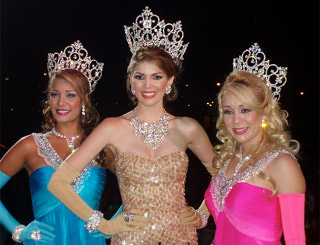Panama: The Most Intriguing Isthmus
Mandarine Napoléon Hosts Mix-Off
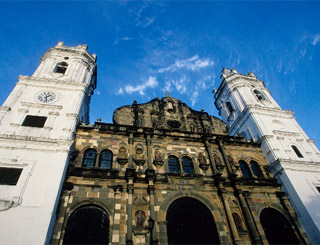
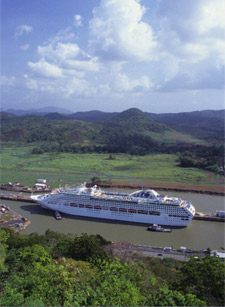
Charles Greenfield is a Miami-based travel writer who has contributed to Travel & Leisure and regional magazines/ newspapers. He also is Cultural Arts Contributor to Artsbeat on WLRN 91.3 FM, South Florida’s NPR affiliate, a producer for WLRN Ch. 17’s Artstreet, and has written on classical and jazz musicians for the Miami Herald.
The republic of Panama is blessed with a myriad of natural gifts, from over 1,800 islands on both Pacific and Caribbean coasts to pristine rainforests with 3% of the world’s biodiversity, all contained in an isthmus, a narrow strip of land with sea on either side squeezed between two larger areas of land. But, of course, its immediate fame rests on the 50 mile-long Panama Canal, the miraculous series of locks and lakes hewn out of once “yellow fever” jungle over one hundred years ago by the French and U.S. that today transits over 300 million tons of shipping annually. The size of South Carolina, the bi-lingual democratic nation of only 3.4 million multi-racial inhabitants flourishes through trans-shipping and Canal expansion (post-Panamax ships), the world’s second largest Free Trade Zone, over 100 international banks, and expanding tourism. According to Tourism Minister Salomon Shamah, Panama should be considered the industry’s “best kept natural secret”.

On a recent trip with French and Dutch journalists during Carnival week in Panama City, I was fascinated by the contrast of restored 17th century Spanish Colonial style buildings, some transformed into cute boutiques, restaurants, and bars, and a booming business skyline sprouting up all around the Pacific coastline capital. Architecture runs the gamut from the Casco Viejo (Old Town), a World Heritage Site, a warren of archways, colonnades, terraces and fortified malecon (boardwalk) to the 72-story Trump Ocean Club with its taut, bow-like “deployed sail” structure or the Revolution Tower, a helical-shaped 51-story office high rise that resembles a giant power drill bit. There’s even a jagged Frank Gehry-designed Museum of Biodiversity (open 2012) on the 2-mile long Amador Causeway just outside the city center near the southern entrance to the Panama Canal.
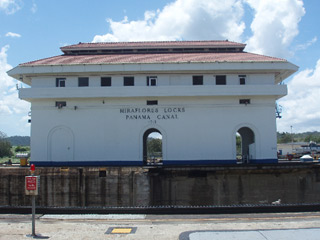
Our group stayed in the busy commercial downtown zone off Avenida Central España at the newly renovated Hotel El Panama, the country’s first “Hilton,” with a retro circle-eight pool and cabanas, swim-in palapa-thatched bar, oversized guest rooms with wi-fi, all-marble bathrooms with double sinks, an excellent breakfast and lunch buffet at Flamingo’s café, and two adjacent casinos, Fiesta and Veneto. From the hotel it’s a half hour ride to the Miraflores Visitors Center on the Panama Canal with its small museum, 10-minute film, gift shop, and excellent panoramic buffet restaurant (managed by Hotel El Panama). With our guide we crossed over a tiny walkway to a set of locks and spent a riveting hour watching the 82-foot high, 790-ton twin gates swing open to raise the water level as “mulas” or tank-like locomotives pulled cables on both sides of the Singapore-owned 17,000 ton vessel, Ikan Sepat. While the enormous 75-foot wide bulk carrier barely slipped through the lock, it was exhilarating to acknowledge 1914 American engineering still functioning seamlessly. A “third ditch” (2014) is currently being dug to accommodate 37% of the world’s super tankers that are too wide for the existing locks.
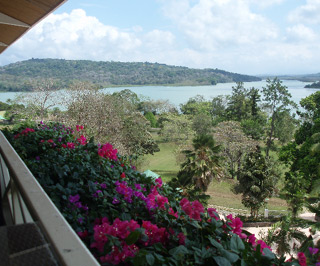
A short distance from Miraflores at Gamboa Rainforest Resort visitors can enjoy a more intimate view of the Canal, the Chagres River, and the Soberania National Park Rainforest. We took the resort’s Monkey Island boat tour that offered a low level glide along the Canal past huge container ships on our way to spot howler monkeys cavorting, scratching, and posing near small concrete huts once used by the U.S. military for jungle warfare training. In the enormous nearby Gatun Lake the resort also provides fishing excursions for peacock bass, tilapia and snook. After the one hour tour we had a fine lunch of Panamanian-style sancocho, a mix between soup and stew, with chicken, ñame (yam) or yucca, and culantro (stronger version of cilantro), breaded corvina (sea bass), sweet plantains, arroz con guandu (rice and beans), and very tasty French-style pastries.
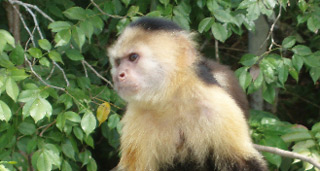
Leaving Gamboa we drove to close-by Canopy Tower, formerly a U.S. Air Force radar station, now a birdwatcher’s paradise, smack in the middle of 35 acres of the Soberania rainforest, a major world avian crossroads. Owner Raul Arias and his wife run the 12-room tower eco-lodge where guests can view spotted ant birds, tiger-eye snakes, howlers, sloths, ant-eaters, and keel-billed toucans in the large guarumo or umbrella trees in early morning or late afternoon sightings. Afterwards, we journeyed east to the end of the Canal off the port of Colon and wandered in the ruins of Fort San Lorenzo at the mouth of the Chagres and Caribbean sea. Here, Captain Henry Morgan captured the fort on his astonishing overland victory west against the Spanish ending with the sacking of Panama City (Panama Viejo) in 1671 . From this historic sequestered vista, the confluence of river, sea and fortress evoke a strong nostalgia of piracy and conquest framed by enormous barrigon trees filled with two-foot hanging nests guarded by the splendid chestnut-headed, orange-beaked, yellow-tail
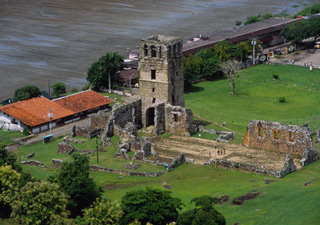
Back in the capital we celebrated the end of the Carnival week with a dinner of carpaccio of mushrooms, corvina in tamarind sauce, and a fine classic baked Alaska at the elegant Bristol Panama hotel. Then it was off to see Queen Yinnela Yero Torres and her two princesses on the Avenida Balboa waterfront. In resplendent costumes, they paraded first on themed floats or “desfiles,” followed by a “tuna” or group of musicians, and then they smiled and waved on open stage with folkloric dancers before an adoring crowd of locals supported by a blasting brass band. Certainly, it was more rough-edged than the world-famous Brazilian model, but after gazing at the Queen and her court my skeptical heart did jump a beat or two. In an increasingly homogenous world of tourism, Panama provides more than a few surprises.
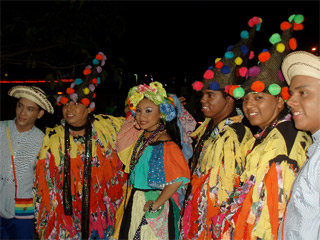
For information contact:
visitpanama.com
elpanama.com
gamboaresort.com
canopytower.com
thebristol.com
